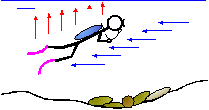Diving
You can call the Municipality (during office hours!) where you intend to dive, they will give you the information you need or, if necessary, will tell you where you can have a precise answer.
You can ask the Municipality about the local diving Societies who offer this service and know the place.
In the website WWW.CMAS.CH you find a list of societies active in the region you are interested in.
No, in the river you have to get rid of what you don’t need; the depth is very limited, normally does not exceed 5-7 m. Besides, there is always the possibility of finding yourself in the current, even if it is minimum, or the risk finding yourself trapped between the rocks; less material fits better (no jacket, tools, cylinders more than 10 liters, octopus, watertight suit,....)
The most reduced and essential possible. The following list gives you an idea about the personal equipment:
- single cylinder of 10 liters;
- Back-pack (if not available a Jacket is fine, but without joining the air load hose);
- 1 valve bi-stage without hoses and gauges;
- watertight suit;
- ballast, +2kg with respect to the usual weight;
- mask;
- flipper.
The watertight suit does not allow rapid and agile motion. Besides, air can get into it.
These two reasons can cause an unpleasant surprises as:
- to be able to survive small currents you should be able to move with certain speed and smoothness;
- a bad control of the load / unload of the air of the watertight suit could cause a quick floating to the center of the river, where the current is more intense.
Because the effect of the current creates on the diver body a force that pushes him towards the surface of the water where the current is stronger.

Because a wrong load or unload of the jacket could carry the diver quickly to the surface and to the center of the current where its intensity is higher. This would put the diver in the danger of being driven away by the downstream.
By preparing a route on the bottom that indicates the way back with white plastic bags tied to big stones to maintain their positions.
The positioning of the bags starts from the bank while leaving a reasonable distance between the bags in order not to lose the track.
To choose where to place the bags you have to consider that the route should be realized in a place where there is no current, upstream from the beginning of the danger and sufficiently far in a way that it is not possible for the diver to enter the dangerous zone.
When the diving activity is over, the person in charge, who will get out the last, has to collect the bags from the river bed (you can leave the stones!)

NO - the purpose of the safety rope is to indicate to the diver the way out of the water.
However, the method of the bags is better, as it is hard to see the rope from the bottom.
If you think of using a rope, be sure to position it in a place where there is no current, upstream from the beginning of the danger and sufficiently far in a way that it is not possible for the diver to enter the dangerous zone.
Generally, the average speed of water flow at the exit of the pool is 3.5m/s; the maximum limit for a diver to cling to the rope is 2.5m/s!
To conclude, it is a mistake to think that the rope is the last resort for a diver in troubles.
The strongest current is in the center of the stream and in the surface. For this reason, diving has to be on the bottom and towards the edges of the river.
With accurate observation:
In the surface it is not possible to see it, you can use some sticks or leaves. On the bottom you can follow the rule: where there is sand there is no current, the big stones are a sign of a weak current, the clean bottom, with no stones or sand pockets, is a sign of the presence of a strong current.
A syphon is a passage under an obstacle, normally a boulder. It is a very dangerous point, as the diver can get stuck there; it is difficult for him to succeed getting out without assistance. Normally, the current in the syphon is strong as the section of water passage is inferior (the Venturi effect). It is difficult to locate a syphon from the surface; if you see a hole under a rock while diving do not approach.

It is important to begin downstream; by doing so you can see exactly where the exit point is situated, moreover, by going upstream you the risk of dragging yourself into dangerous traps like syphons. If you arrive on a downstream syphon the water will push you away; if you arrive from the top you will be swallowed!!.
Our rivers have very spacious basins and a very short latency time, which means if there is a storm in the mountain the water level will increase considerably right after.
Listen to the weather forecast and get informed, if it is possible, from the people of the area.
On the diving place the sun can create a strong storm upstream. In a time shorter than what you may imagine you can find yourself in front of increasing water and real safety troubles.




